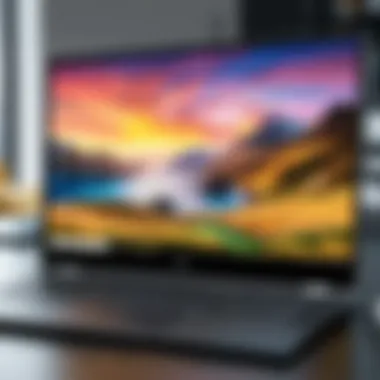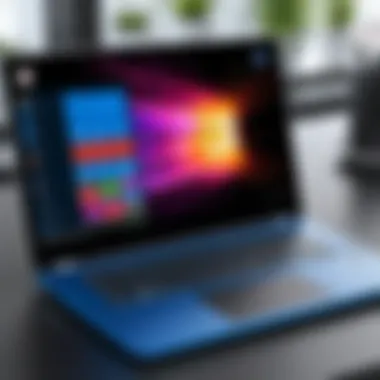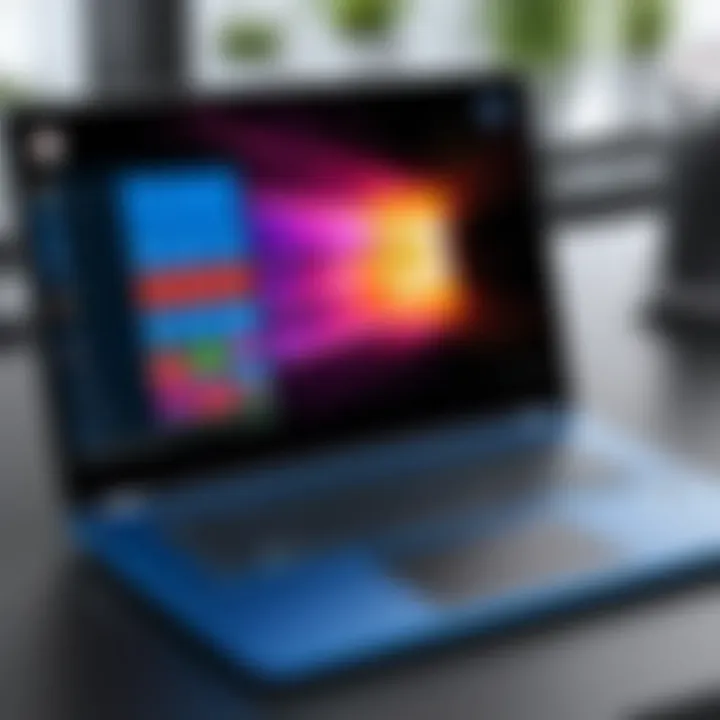The Ultimate Guide to Choosing the Best Windows 10 Laptop


Intro
Choosing the right laptop running Windows 10 is a significant decision for anyone looking to enhance their digital experience. With a plethora of options available, it is critical to navigate through numerous features, specifications, and user requirements.
This guide aims to demystify the selection process. It will cover essential aspects including performance indicators, design considerations, and specific product offerings that meet varied user needs. Whether for work, play, or a blend of both, understanding how different laptops perform with Windows 10 can substantially impact productivity and enjoyment.
Key Features
Design and Build Quality
When selecting a Windows 10 laptop, the design and build quality are fundamental. A durable laptop not only looks appealing but can withstand daily wear and tear. Materials such as aluminum and magnesium alloy are preferable, as they provide sturdiness without excessive weight.
The laptop's weight and dimensions matter significantly. An ultrabook is easier to transport, while gaming laptops often prioritize performance over portability. Consider how often you will carry your laptop to determine the best fit.
Display and Performance
The display quality plays a crucial role in user experience. Factors such as resolution, color accuracy, and brightness should guide your choice. High-definition screens with IPS panels generally offer a better viewing experience, making them ideal for creative tasks and media consumption.
Performance is where the laptop's internals come into play. Look for processors from Intel, like the i5 or i7 series, or AMD Ryzen 5 or 7. RAM capacity should typically start from 8GB for basic tasks and rise to 16GB or more for heavy multitasking.
Laptops also vary in graphics performance. Integrated graphics may suffice for everyday tasks, but dedicated GPUs, like those from NVIDIA or AMD, are essential for gaming and graphic-intensive applications.
Product Specifications
Technical Specifications
Understanding the technical specifications is vital for making an informed decision. Here are some key aspects to look at:
- Processor: Intel Core i5/i7 or AMD Ryzen 5/7
- RAM: Minimum 8GB, ideally 16GB or more for advanced uses
- Storage: SSDs are faster than traditional HDDs. Aim for at least 256GB SSD.
- Battery Life: Look for laptops that offer at least 8 hours of battery life.
Compatibility and Connectivity
Ensure the laptop you choose is compatible with essential software and peripherals. For Windows 10 users, most applications are compatible; however, specific tools for work or design may require certain specifications.
Connectivity options are crucial as well. Ensure the laptop has sufficient USB ports, including USB-C and HDMI for easier connections to monitors and other devices. Wi-Fi 6 capability is beneficial for better internet speeds and connectivity.
In exploring the best Windows 10 laptops, understanding these features can empower you to make a well-informed decision that aligns with your needs.
This guide will further delve into reviews of top models, equip you with optimization tips, and illustrate how to leverage Windows 10’s capabilities for maximum productivity.
Prologue to Windows and Its Features
Understanding Windows 10 is crucial for selecting the best laptop for your needs. As one of the most popular operating systems, Windows 10 offers diverse features that can enhance productivity and overall user experience. In this section, we will explore the fundamentals of Windows 10, including its key features and how it shapes the user interface.
Overview of Windows
Windows 10 was launched in July 2015 and marked a return to a more conventional operating environment following the rather controversial Windows 8. The system blends traditional PC features with modern capabilities. It aims to be user-friendly, catering to a wide variety of users. Windows 10 is designed to work across multiple devices, including tablets and laptops, ensuring users enjoy a seamless experience regardless of their chosen device.
The approach fit into a broader vision of a unified experience within the Windows ecosystem. This is especially relevant as many rely on devices that integrate with each other, necessitating an operating system that performs well in various contexts.
Key Features of Windows
Windows 10 separates itself from previous iterations through several standout features:
- Cortana: This virtual assistant can help with searches, reminders, and even controlling smart home devices.
- Microsoft Edge: The replacement for Internet Explorer, Edge is designed for better performance and security while browsing.
- Virtual Desktops: This feature allows users to create multiple desktop environments, helping to organize workspaces better.
- Windows Ink: For those utilizing touch screens, Windows Ink offers a suite of tools for drawing and note-taking directly on the screen.
- Updates and Support: Continuous updates maintain security and usability, which is vital in today’s technology landscape.
These features not only enhance general usability but also cater to specific user demands, making Windows 10 a versatile choice for laptop users.
User Interface and Experience
Windows 10 presents a familiar interface, which is especially beneficial for users transitioning from earlier versions. The Start Menu combines elements from Windows 7 and Windows 8, providing easy access to apps and settings. The interface is designed with the user in mind, focusing on ease of navigation and accessibility.


One important aspect of user experience in Windows 10 is its adaptability. The OS adjusts to various display sizes, making it equally functional on tablets and larger laptops. Each component helps create an environment where users can work efficiently. Therefore, understanding Windows 10’s interface is essential as it directly influences how one interacts with their device.
Identifying User Needs
Understanding user needs is a fundamental step in selecting the best Windows 10 laptop. This section emphasizes the significance of discerning individual requirements, as they directly influence the suitability of a laptop. Different users have varied priorities depending on their tasks, lifestyle, and budget. Identifying these needs helps in narrowing down choices to find a model that best aligns with expectations and performance requirements.
Casual Use vs. Professional Needs
For casual users, a Windows 10 laptop primarily serves daily activities such as browsing, streaming, or word processing. In this context, factors like cost and usability are paramount. A lightweight laptop that provides decent battery life and a user-friendly interface may suffice. Typically, these users do not need cutting-edge specifications nor exceptional graphics performance.
In contrast, professionals require robust performance and reliability. They might engage in resource-intensive tasks, including graphic design, programming, or data analysis. Here, the emphasis shifts to higher specifications such as faster processors and large RAM. Therefore, a professional’s choice might focus on performance benchmarks, durability, and brand reputation. Understanding these differences will guide user selection effectively.
Portability and Battery Life Considerations
Portability is often a critical factor, especially for users who frequently travel or commute. A laptop’s weight, size, and design play essential roles in defining its portability. A lightweight laptop offers convenience, making it easier to carry or move between locations. However, this often comes at the cost of power.
Battery life is another consideration that complements portability. A laptop with extended battery life ensures that users can work or engage with their device without constant recharging. For students or remote workers, a minimum of eight hours is preferable to maximize productivity throughout the day.
Gaming and High-Performance Applications
Gaming enthusiasts and professionals using high-performance applications have distinct requirements. They seek superior graphics capabilities, fast refresh rates, and efficient cooling systems to ensure seamless experiences even during demanding tasks. Choosing a laptop for this purpose often entails looking into dedicated graphics cards such as the NVIDIA GeForce series or AMD Radeon graphics.
The balance between performance and price becomes crucial here. Users should consider if they are willing to invest more in better specifications rather than opting for a budget model that may not meet long-term needs. Higher-end options generally provide better gaming experience and longevity in the fast-evolving tech landscape.
"Identifying user needs is the cornerstone of effective laptop selection, ensuring a good match between requirements and capabilities."
This section serves as a primer for users to reflect on their individual requirements. Assessing personal needs makes it easier to navigate the extensive laptop options available, ultimately leading to a more satisfactory investment.
Performance Metrics
Performance metrics are vital when selecting a laptop with Windows 10. They directly influence how well the device meets user needs. Understanding these metrics helps in making educated choices that align with specific tasks, whether for casual, professional, or gaming purposes. In this section, we will clarify the essential performance metrics, including processor types, memory capacity, storage options, and graphics performance. Each of these elements contributes significantly to the overall efficiency and effectiveness of the laptop, informing a user's experience.
Processor Types and Their Impact
The processor, or CPU, serves as the brain of a laptop. It executes instructions and processes data, thus affecting the speed and performance of software applications. Different processors have varying capabilities, and understanding these can help in selecting the right laptop.
Common processor types include Intel Core i3, i5, i7, and i9, as well as AMD Ryzen 3, 5, 7, and 9. Each tier represents distinct performance levels. For example, the Core i5 and Ryzen 5 are suitable for most daily tasks, while the i7 and i9 models cater to heavier workloads like video editing and complex applications.
Additionally, the number of cores in a processor plays a crucial role in multitasking. More cores can handle more processes simultaneously, resulting in better overall performance. Therefore, when considering a laptop, examining the processor type and core count is fundamental to ensuring sufficient capability for intended use.
Memory and Storage Requirements
Memory, or RAM, is another critical aspect impacting laptop performance. It allows for temporary storage of data that is actively being used, which enhances overall speed and responsiveness. For basic activities, such as browsing the web or word processing, 8 GB of RAM is often adequate. However, for users involved in graphic design, programming, or heavy multitasking, 16 GB or more may be necessary to prevent bottlenecks.
Storage options primarily revolve around Solid State Drives (SSD) and Hard Disk Drives (HDD). SSDs are significantly faster than HDDs, resulting in quicker boot times and swift loading of applications. However, HDDs can offer larger storage capacities for a lower price. Depending on usage habits, a combination of both may be preferred. A laptop with an SSD can enhance performance drastically, while ample storage helps manage large files effectively.
Graphics Performance Factors
Graphics performance is essential for users engaging with visual content, such as video games or design work. Integrated graphics are suitable for casual use, such as streaming and everyday tasks. In contrast, dedicated graphics cards, like those from NVIDIA and AMD, are ideal for demanding applications, providing higher frame rates and better rendering quality.
The quality of graphics performance can be evaluated through metrics like frame rate and resolution. Laptops equipped with dedicated GPUs offer superior visual experiences, particularly at high resolutions. For gamers or creative professionals, ensuring that the chosen laptop has a capable graphics card is critical.
"Understanding performance metrics empowers users to make informed decisions, aligning their laptop capabilities with their personal or professional demands."
Comparative Analysis of Top Windows Laptops
Selecting the right laptop often involves comparing various options available in the market. This section emphasizes the importance of conducting a comparative analysis of top Windows 10 laptops. With numerous brands and models, understanding the strengths and weaknesses of each can guide buyers in making informed decisions.
A comparative analysis helps to evaluate the features that matter most to the user. Factors like performance, battery life, and design play crucial roles in the selection process. Moreover, it is essential to consider the target audience, whether they are professionals needing high-end specs, students looking for budget-friendly options, or gamers wanting top-tier performance.
Understanding how different models perform under various conditions can significantly impact satisfaction. Such an analysis not only helps to identify the best option but also aids in weighing the value against the price, ultimately ensuring that one selects a laptop that meets both needs and expectations.
High-End Laptops for Professionals


For professionals, high-end laptops are a necessity for handling demanding tasks and software. These laptops usually come with powerful processors, such as the Intel Core i7 or i9 and AMD Ryzen 7 or 9. These processors provide exceptional performance for multitasking, rendering, and complex data analysis. Brands like Dell XPS 15, Microsoft Surface Laptop 4, and HP Spectre x360 are leading choices in this category.
Key elements to consider in this segment include:
- Display Quality: High-resolution displays are essential for graphic designers and content creators. 4K screens enhance detail and color accuracy.
- Build Quality: Durability and aesthetics matter. Premium materials not only feel good but also improve the laptop’s lifespan.
- Portability: Weight and thickness are crucial, especially for professionals on the go. A lightweight laptop can significantly enhance mobility.
Affordable Options for Students
Students often have limited budgets but still require laptops that perform well for everyday tasks. Affordable Windows 10 laptops can offer great value, balancing performance and price effectively. Options like Asus VivoBook or Acer Aspire series provide reliable performance without draining one’s finances.
When looking for student-friendly laptops, consider these aspects:
- Performance: Laptops with Intel Core i3 or AMD Ryzen 3 can handle casual use, like web browsing and document editing.
- Battery Life: Students should focus on laptops with long battery life for all-day usage in class or the library.
- Weight: Lightweight models are convenient for carrying around campus.
Gaming Laptops: Performance vs. Price
Gaming laptops require a careful balance between high performance and a reasonable price. They need specialized graphics cards like NVIDIA GeForce or AMD Radeon to run modern games smoothly. Laptops such as ASUS ROG Zephyrus and Acer Predator Helios 300 are examples that perform well in gaming scenarios.
When analyzing gaming laptops, two main factors should be weighed:
- Hardware Components: Look for at least a mid-tier graphics card and a solid processor for a good gaming experience.
- Cooling Systems: Gaming sessions can heat up laptops quickly, hence effective cooling systems are essential.
"Choosing a gaming laptop is not just about raw power; it's about finding what fits your preferences and budget."
Design and Build Quality
The design and build quality of a laptop are critical factors that significantly impact the user experience. A well-constructed laptop not only adds to the aesthetic appeal but also contributes to the durability and longevity of the device. In today’s competitive market, understanding these aspects ensures that users make informed decisions when selecting their ideal Windows 10 laptop.
Material Choices and Durability
Material choices play a significant role in the durability of a laptop. Laptops are commonly constructed from materials such as aluminum, magnesium, and plastic. Aluminum laptops are often favored due to their sturdy build and premium feel. They tend to withstand daily wear and tear better than plastic counterparts. However, they can be heavier, which might not appeal to users focused on portability.
Magnesium is another material that offers great strength while remaining lightweight. Manufacturers often use it in high-end laptops to balance durability with ease of transport. On the other hand, plastic can still offer satisfactory durability, especially in budget-friendly models, but it may feel less robust and might not endure the same level of impact as metal.
Durability is not just about the materials used but also how the laptop is assembled. For instance, models like the Dell XPS series are known for their excellent build quality, featuring tight hinges and sturdy frames that resist flexing under pressure. Careful consideration of material and construction methods can lead to a more reliable device.
Design Aesthetics and Ergonomics
Design aesthetics influence the overall appeal of a laptop. A sleek, modern look can enhance user satisfaction, making it more enjoyable to use. Brands like Apple and HP emphasize aesthetics with their clean lines and minimalist designs. Customization options, such as color choices, further allow users to express their personal style.
Beyond looks, ergonomics are equally crucial in a laptop’s design. Factors such as keyboard layout, trackpad responsiveness, and screen tilt affect how comfortable it is to use for extended periods. A laptop with an ergonomic design, like the Lenovo ThinkPad series, usually features a comfortable keyboard, spacious trackpad, and a display that tilts back enough to reduce glare, which helps to avoid strain during long working hours.
Choosing a laptop is not only about its specifications but also how it feels during use. Comfort can enhance productivity significantly.
Operating System Optimization
Operating system optimization plays a crucial role in enhancing the overall performance and longevity of a laptop running Windows 10. For users, ensuring that the system runs efficiently is paramount, as it can significantly affect their productivity and experience. An optimized operating system minimizes crashes, improves responsiveness, and prolongs battery life. Understanding how to optimize Windows 10 involves recognizing both the inherent features of the OS and the necessary adjustments for peak performance.
Windows Updates and Maintenance
Regular updates are essential for maintaining a robust Windows 10 experience. Microsoft frequently releases updates that address security vulnerabilities, enhance features, and resolve bugs. Hence, keeping the system updated can protect the laptop from potential threats while providing access to the latest functionalities.
Users can configure Windows 10 to automatically download and install updates, ensuring a consistently secure environment. However, some users might prefer manual control over the process, allowing them to schedule updates during non-peak hours to prevent interruptions.
Additionally, routine maintenance is critical. This includes disk cleanups to remove unnecessary files, defragmenting the hard drive, and managing startup programs that can slow down system boot time. Tools like Disk Cleanup and Storage Sense can assist in this process, freeing up valuable space and helping to maintain an optimized system.
"Updating your OS regularly reduces security risks and keeps everything running smoothly."
Enhancing Performance through Settings
To achieve optimal performance with Windows 10, users should adjust specific settings that can influence how the operating system manages resources. These adjustments can lead to substantial increases in speed and responsiveness.


- Visual Effects: Windows 10 includes many visual features that can consume system resources. Disabling some of these effects can speed up performance, especially on older hardware. Users can access these options in the Performance Options settings.
- Power Settings: Modifying power settings also affects laptop performance. Selecting a high-performance power plan can lead to better responsiveness, particularly for demanding applications. However, users should be cautious as this setting can increase battery drain.
- Background Applications: Limiting background applications is another method for enhancing performance. In the Settings menu, users can review and restrict which applications can run in the background, freeing up processing power for primary tasks.
By investing time in these settings, users can personalize their Windows 10 experience, ensuring that the system not only meets their unique needs but also functions at its highest potential.
Customer Support and Warranty Considerations
When selecting a laptop, one often focuses on technical specifications and performance. However, understanding customer support and warranty considerations is equally crucial. These aspects can significantly influence the long-term ownership experience. Poor support can lead to frustration and additional costs, while a robust warranty can bring peace of mind.
Understanding Warranty Offerings
A warranty is a promise from the manufacturer about the laptop's reliability. Most laptops come with a standard warranty, often ranging from one to three years. It covers hardware defects but may vary in scope. Here are some key points to keep in mind when evaluating warranty offerings:
- Duration: Longer warranties might be beneficial, especially for expensive models.
- Coverage: Check what is specifically included or excluded. Some may cover parts, while others might cover labor costs as well.
- Accidental Damage Protection: Some manufacturers offer additional coverage for accidental damage. This can be useful for users prone to mishaps.
- On-site vs. Mail-in service: Understand whether repairs can be done at your location or if you need to send the laptop away, which can be inconvenient.
It’s critical to read the warranty documentation carefully. Understand the steps you must follow should you need to claim the warranty. Failing to do so may cause delays in getting the support you require.
Manufacturer Support Reputation
The reputation of the manufacturer regarding support is another important factor. Not all brands are equal in their commitment to customer service. A laptop from a company known for excellent support can save time and reduce stress. Here are some aspects to consider:
- Response Time: Evaluate how quickly the manufacturer responds to queries. This can be a good indicator of overall support quality.
- Availability: Determine support hours and whether it's available online, via phone, or in-store. Some companies offer 24/7 support, while others have limited hours.
- User Reviews: Reading customer reviews on platforms like Reddit or tech forums can provide real insight into actual user experiences. Look for patterns in complaints or praises regarding support.
- Replacement Parts: Check the availability of replacement parts for your laptop model. If parts are hard to find, it might affect service in the long run.
"Excellent post-purchase support is often as valuable as the laptop's performance itself."
When choosing a laptop, don’t neglect these support elements. The combination of a thoughtful warranty and reputable manufacturer support can significantly enhance your experience.
Future Trends in Laptop Technology
As technology continues to evolve rapidly, understanding future trends in laptop technology is essential for anyone looking to purchase a new Windows 10 laptop. This section delves into specific elements that are driving innovation in laptops, including performance enhancements and efficiency improvements. Keeping an eye on these trends helps consumers make informed decisions that align with their needs, ensuring they choose a device that will remain viable and efficient for years to come.
Advancements in Laptop CPUs
The central processing unit (CPU) is often referred to as the brain of the computer. Recent advancements in CPU design and architecture have played a significant role in enhancing the performance of laptops.
A few notable trends in CPU technology include:
- Increased core counts: More cores allow for better multitasking and improved performance in demanding applications.
- Energy efficiency: Modern CPUs are designed to maximize performance while minimizing power consumption, which is crucial for battery life and heat management.
- Integrated graphics improvements: Many CPUs now come with powerful integrated graphics, reducing the need for a dedicated graphics card for everyday tasks, thus lowering costs and system complexity.
- AI and machine learning: Increasingly, CPUs support AI workloads, making laptops smarter and more responsive to user needs.
Each of these advancements contributes significantly to the functionality of Windows 10 laptops, enhancing the overall user experience.
The Future of Battery Technology
Battery technology directly impacts the portability and usability of laptops. As users increasingly rely on their devices for work and play, the demand for lasting battery life grows more urgent.
Some trends influencing battery technology include:
- Solid-state batteries: These batteries promise higher energy density and faster charging times, which means longer usage between charges.
- Fast charging: New technologies allow for rapid recharging, minimizing downtime for users and making laptops more convenient for mobile use.
- Battery management systems: Enhanced software solutions are being developed to optimize battery use, extending the overall lifespan and performance of the battery.
- Sustainable options: The push for environmentally friendly solutions is driving innovation in battery materials and recycling processes.
"The future of battery technology will redefine how we interact with our laptops, removing limitations that have long constrained mobile computing."
In summary, by staying informed about these future trends in laptop technology, users can select a Windows 10 laptop that not only meets their immediate needs but also stands the test of time as technology advances.
Epilogue
The conclusion serves as a vital part of this article, encapsulating the essence of selecting the best Windows 10 laptop. It synthesizes the information presented in the previous sections, emphasizing the alignment of user needs with hardware specifications. By revisiting key themes, it helps readers solidify their understanding of the factors they should consider in their selection process.
Many elements come into play when choosing the right laptop. Performance metrics, such as processor types and memory requirements, must align with the intended use, whether it be for casual tasks, professional applications, or gaming. Sometimes, overlooked aspects like durability and design aesthetics can significantly influence long-term satisfaction with the device. The discussion around customer support and warranty considerations reinforces the practicality of making an informed decision.
From assessing trends in laptop technology to reflecting on ways to optimize Windows 10 for enhanced productivity, this article addresses diverse aspects relevant to tech-savvy individuals. Readers seeking to maximize their investment can benefit from the insights derived throughout the text.
In summary, this concluding section is not just a wrap-up but a call to action. A well-informed choice will lead to better satisfaction, productivity, and enjoyment of technology. Investing time in evaluating the options available and understanding individual needs makes all the difference.
Final Thoughts on Choosing the Right Laptop
Choosing the right laptop is a decision that extends beyond mere specifications. It requires a clear understanding of one's own requirements, preferences, and future needs. Each laptop comes with its unique set of features, strengths, and weaknesses. Therefore, engaging with the outlined criteria can foster a deliberate approach.
- Assess one’s own usage patterns.
- Prioritize the features that matter most.
- Keep future advancements in mind when making a purchase.
Ultimately, a laptop is an investment in productivity and creativity. Therefore, being methodical in the decision-making process ensures that the final choice aligns closely with personal or professional needs. The right laptop can elevate one’s work and leisure experience with Windows 10, making your selection process a significant endeavor.



